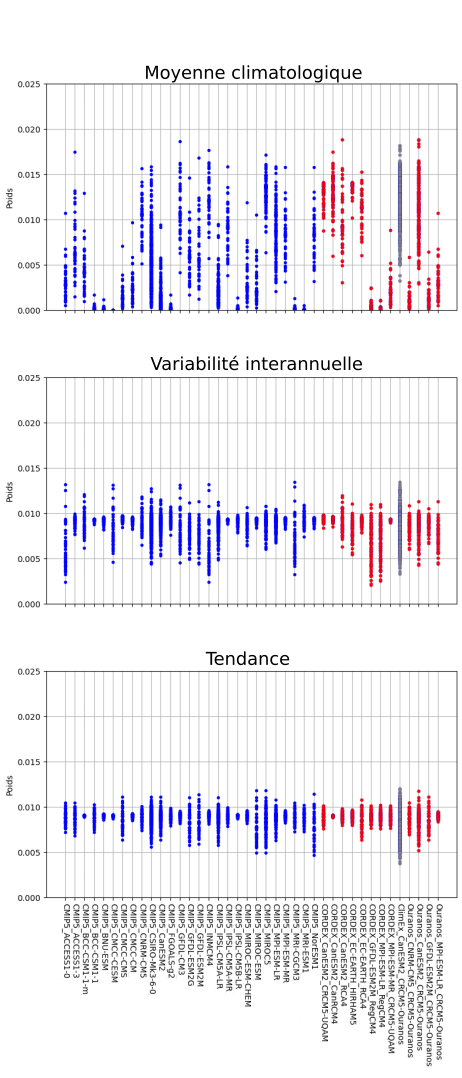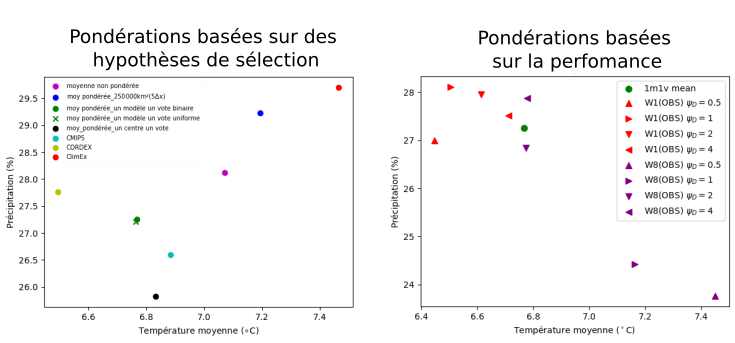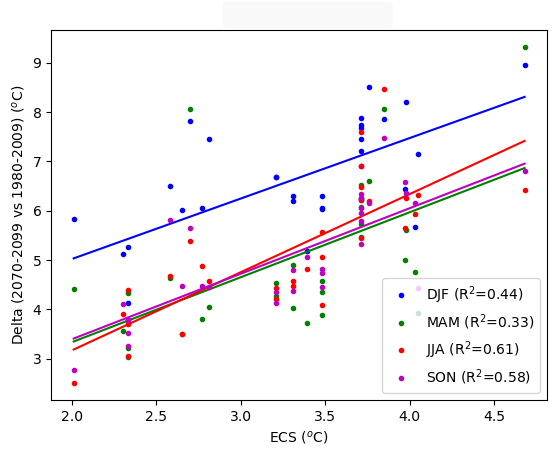Assessing the value of weighting a heterogeneous climate model ensemble to improve future hydroclimatic projections over southern Quebec
This project has advanced our understanding of how heterogeneous ensemble simulations should be combined to maximize the information contained in climate projections.
Project details
Principal(s) investigator(s)

Context
To predict the evolution of floods in the context of climate change, the Direction de l'expertise hydrique (DEH) produced an ensemble of hydrological simulations for about 28,000 river reaches in Québec. These simulations use climate projections from several different climate models. While this state-of-the-art ensemble includes most available simulations and offers a wide variety of projections of future climate change, it was not built according to the models’ performance in simulating observed climate, nor their credibility in making future climate projections.
In this project, we will explore the usefulness of weighting this heterogeneous model ensemble (i.e. giving more importance to certain simulations according to specific criteria) to improve hydroclimate projections for Québec.
Objective(s)
-
To assess the ability of climate models to reproduce the main features of the historical climate
-
To identify evaluation metrics for determining model performance
-
To analyze the effect of combining several evaluation metrics in a single weighting scheme
-
To quantify the impact of methodological weighting choices on climate projections
This project is part of the INFO-Crue initiative set up by the MELCC.
Methodology
-
Extract a heterogeneous ensemble of climate models based on the CMIP5, CORDEX and ClimEx projects for the southern Quebec domain.
-
Analyze the performance of simulations (raw and post-processed) for various climatic indicators of interest in hydrology.
-
Associate weightings with models based on performance metrics.
-
Evaluate the sensitivity of weightings to different parameters, including adjustment of the weighting function and the combination of several performance metrics.
-
Use the 50 members of the ClimEx ensemble as pseudo-references to assess the impact of internal (natural) variability on weighting calculations.
-
Compare performance-based weighting of climate projections with selection methods based on model characteristics (e.g. resolution and model type).
Results
The raw and post-processed simulations were evaluated in the past climate for the main climate statistics of temperature and precipitation variables. These statistics correspond to climate averages, interannual variability and historical climate change trends. In addition, the NRCan gridded dataset was used as a reference. By design, post-processing systematically improves the temperature and precipitation climate averages. However, such improvements do not occur for interannual variability and historical climate change trends.
The impact of internal variability on the calculation of performance weightings was also assessed. Figure 1 shows the distribution of weightings obtained for the models evaluated using members of the ClimEx ensemble as pseudo-references. Uncertainty for weightings is generally small for climate averages and substantial for interannual variability and trends, which are strongly influenced by internal climate variability.

Figure 1 : Weightings calculated for climate average, interannual variability and historical mean winter (DJF) temperature trend, using the 50 ClimEx members in turn as pseudo-references.
In addition, applying different weighting methods to calculate the average climate change with regard to temperature and precipitation has a quantified impact. Figure 2, on the left, compares the weighted averages obtained by different selection methods based on model characteristics, such as model type (regional or global) and spatial resolution, or according to certain selection paradigms such as “one model, one vote” or “one centre, one vote.” The panel to the right of this figure shows the same climate change variables, but weighted according to the climatological performance of the models, with different configurations of the weighting function. The uncertainty of the weighted signal is relatively low despite strong selection and weighting hypotheses. However, it is important to point out that the ensemble used here comprises fifty models, so greater uncertainty is expected for smaller simulation ensembles.

Figure 2 : Delta of winter temperature and precipitation for 2071-2100 compared with 1981-2010 (based on RCP8.5) using different weighting methods. On the left: for weightings based on model selection hypotheses. On the right: for different configurations of performance-based weighting.
Lastly, the assessment of a relationship between global climate sensitivity (ECS, for equilibrium climate sensitivity) and regional climate change is another analysis of interest in this report. Figure 3 shows that such a relationship exists for temperature, but not for precipitation (not shown). However, it has been recognized by the community (IPCC 2021) that the ECS interval considered likely is 2.5 to 4°C (Hausfather et al., 2022). The simulations used in Figure 2, based on the generation of CMIP5 models, show an ECS varying between 2°C and 4.7°C. This leaves little room for constraining the uncertainty of projections using ECS. However, for the CMIP6 ensemble, where more than a quarter of the models have an ECS greater than 4.7°C, ECS makes it possible to constrain the uncertainty of the regional temperature signal more significantly.

Figure 3 : Seasonal temperature delta in southern Quebec for 2071-2100 vs. 1981-2010 (based on RCP8.5) as a function of the equilibrium climate sensitivity (ECS) of the global model used.
In conclusion, this report reminds us that the paradigm of model democracy, also known as “one model, one vote,” is difficult to discredit when climate projections are studied on a regional scale. This is largely due to the high internal variability at these scales. In order to change the paradigm, it will be important over the next few years to carry out research aimed at identifying the most appropriate metrics for assessing model performance depending on the application, i.e. in accordance with the nature of the physical processes involved. In particular, there is potential for work seeking to establish links between the global and regional scales of projections, eventually reaching the hydrological scale.
Benefits for adaptation
Benefits for adaptation
This analysis validated the climate scenarios used by the MELCCFP in the publication of the 2022 Hydroclimatic Atlas of Southern Québec.
The results of this project could influence climate model selection and weighting practices in a number of climate change-related initiatives, including flood risk and water resource management, by providing information on the advantages and limitations of different approaches.
Scientific publications
Funding

Other participants
-
Direction de l'expertise hydrique (MELCC)
Related projects
701000